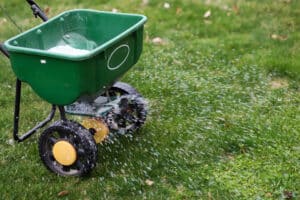If you want a lush, green lawn, you’re not alone. You don’t have to spend a ton of money on sod to take a shortcut to reach your lawn goals. By choosing the right grass type for your location and planting at the optimal time, you can fast-track the process of establishing your lawn from seed without damaging the surrounding soil.
This guide will walk you through the process of establishing a new lawn and provide tips for promoting healthy growth and coping with common setbacks. We’ll also explain how a professional lawn care service can help you maintain a flourishing lawn in the long run.
Find Lawn Help
- See our list of top lawn care companies based on in-depth research.
- Select the company that best meets your needs.
- Get a free, no-obligation quote for your home.
Get a Quote From Lawn Professionals Near You
Compare quotes from local pros
Clicking “Get Your Estimate” submits your data to Home Service Quotes, which will process your data in accordance with the Home Service Quotes Privacy Policy.

Lime Soil Amendment

Lawn Fertilization
How Do You Grow Grass Fast?
The best way to grow grass fast is to plant the best grass seed for your climate and help it with water and fertilizer. An even faster—but more expensive—option is to lay down sod, which is grass that’s already grown. Whether you decide to seed or sod, the process starts by selecting the proper turfgrass.
Determining Your Grass Type
Understanding your grass type is a fundamental step in the process. To get the best, fastest growth, you need to pick the ideal species for your local climate—whether it’s a cool-season grass, warm-season grass, or a transitional grass type. If you choose the wrong type, you may see your grass grow quickly, then falter and fail.
Warm-Season Grass
Warm-season grasses grow best in regions with hot summers and mild winters, including the Deep South and Southeast. These grasses can also grow on different terrains, such as the prairie, and most ornamental grasses are considered warm-season grasses. In general, warm-season grasses have vigorous growth from mid-to-late spring through early fall and go dormant in the winter. Their ideal growing temperature is between roughly 80 and 95 degrees Fahrenheit. The best time to plant warm-season grasses is between late spring and summer.
The fastest-growing warm-season grasses include:
- Bermuda grass: This grass type germinates in as little as seven to 10 days.
- Buffalo grass: This variety takes two weeks to 30 days to germinate.
- Centipede grass: This type of grass will germinate in 14–21 days.
Cool-Season Grass
Cool-season grasses’ active growth periods are during early spring and early fall. They grow best in the Northeast, Pacific Northwest, and Upper Midwest and often include grasses that appreciate shade. These grasses are usually green in the winter and turn brown in the summer. Their ideal growing temperature is about 60–75 degrees Fahrenheit. The best time to plant cool-season grasses is in spring or during the fall, about 45 days before the estimated first frost.
The fastest-growing cool-season grasses include:
- Perennial and annual ryegrass: Both germinate in just seven to 10 days.
- Tall fescue: This grass type germinates in 10–14 days.
- Kentucky bluegrass: It typically takes two to four weeks for Kentucky bluegrass to germinate.
If you live in a transitional zone, you’re in luck. Both warm-season grasses and cool-season grasses will grow in your region. Plant warm-season grass first, then overseed it with cool-season grass.
How To Plant Grass Seed
There are several options for planting grass seed. You may look into hydroseeding—an efficient planting process that involves spraying a slurry of grass seed, fertilizer, water, mulch, and wood fiber through a high-pressure hose. Because of the built-in fertilizer, hydroseeding helps your grass grow quickly.
If you opt not to hydroseed, whether you think it’s too difficult to DIY or you don’t want to pay to hire a professional, you can plant seed the old-fashioned way.
- Test the soil: Use a garden store kit to test your soil for nutrient content and acidity. You want to make sure it’s set for optimum grass growth, with proper drainage and the right nutrients.
- Prep the soil: Be sure to remove any debris, including stones and wood. Scratch the soil with a rake and dig about 6 inches down with a spade to remove any roots. Till your soil either by hand or with a rototiller, then mix amendments, mulch, or compost into it based on the test kit’s results. Smooth the area out to make it level, breaking up any clumps.
- Sow the seed: You’ll need a spreader to ensure uniform growth. Use a broadcast or drop spreader in large areas and a hand spreader in smaller ones. Once you’ve set your spreader to the recommended rate, fill it up with just half of the seeds. Seed once in one direction and again in the opposite direction. The crisscross pattern will help with uniformity.
- Top-dress the soil: Place peat moss over your soil to lock in moisture. This layer can also prevent seeds from washing away in heavy rain and protect them from pesky birds.
- Fertilize the soil: Apply a thin layer of starter fertilizer before covering and tamping the soil. Starter fertilizers are low in nitrogen, which is key because too much nitrogen can encourage weed growth and compete with your new grass. Avoid fast-release fertilizers that promise rapid growth, as these are very high in nitrogen.
- Water your lawn: Newly seeded lawns need plenty of moisture to allow the seeds to germinate. Watering once or twice a week won’t cut it in the early stages. Instead, you’ll either need to take a mister and gently spray the area or run a sprinkler at a low setting two or three times a day for five to 10 minutes for the first week or so. When the grass grows high enough to mow the lawn, water your lawn 1–1.5 inches per week so that the soil is moist but not soggy. Always water your lawn before 10 a.m. or between 4 p.m. and 6 p.m. to keep evaporation minimal.
- Mow the grass: It’s time for the first mow once the grass reaches 3–4 inches.
Laying Sod
Sod is, without a doubt, your fastest way to an established lawn since the grass is already germinated. However, it’s expensive and takes a fair amount of work, and fewer grass species are available as sod. You have to install sod as soon as you get it because it begins to spoil quickly on the pallet. Keep it moist while laying it down piece by piece, ensuring it’s smooth and has no gaps. If you have a lot of trees on your lot, you should find a shade-tolerant sod to install.
Quick Tip
- For the best-looking results, we recommend hiring a professional landscaper to lay sod. While you can attempt to do it yourself, sod is already pricey, and you want to protect your lawn investment.
Common Mistakes That Slow Down Grass Growth
Lacking patience isn’t your only challenge when trying to grow grass quickly. You’ll also need to ensure you aren’t sabotaging your progress with the following mistakes.
- Poor preparation: Skipping the prep work may seem the fastest method, but you’ll run into issues down the line. New grass preparation usually involves removing old grass and rocks before planting, making sure you have healthy soil, and spreading grass seed correctly. Without these steps, your grass won’t have a healthy foundation from which to grow, so you may end up with weak grass that weeds can easily overcome.
- Time of year: Want to grow grass as quickly as possible? Timing eliminates all other obstacles. A warm-season grass likes warm weather, whereas a cool-season grass will be happy in cooler weather. Planting outside the right time frame can ruin all your hard work after doing everything else right.
- Wrong species: Suppose you plant the wrong species for your climate. In that case, your grass won’t survive, and you’ll need regular overseeding to see grass growth. Using the wrong grass species will typically leave you with the same weed problem and bare patches you had before. We recommend consulting with a professional to help choose which grass seed your lawn needs.
Professional Lawn Care
After you’ve planted your new grass, we recommend hiring a professional lawn care service to help you keep it looking good. We reviewed TruGreen and found it to be our top choice to ensure your lawn receives the proper care. TruGreen offers five annual plans, covering everything from aerating to soil amendments in every state except Alaska and Hawaii.
Our Conclusion
Growing grass fast doesn’t require luck—it requires the right strategy. When you choose the right grass type for your region, plant during the ideal season, and prepare your soil properly, you set yourself up for a thick, healthy lawn. Watering consistently and avoiding common mistakes, like using the wrong seed or skipping soil prep, helps your grass establish quickly and thrive.
If you want professional help, don’t hesitate to bring in a lawn care professional. Experts can identify issues early, apply treatments effectively, and keep your lawn green year-round. Whether you tackle lawn care yourself or hire help, the steps you take now will determine how quickly your grass grows and how well it lasts.
FAQs About Growing Grass
How do you grow grass fast?
The best way to grow grass fast is to choose a fast-growing species that grows well in your region. Plant it properly and follow proper maintenance. If you want an instant lawn, you should invest in sod.
What type of seeds grow the fastest?
Bermuda grass is the fastest-growing warm-season grass, germinating in as little as 10 days. Ryegrass, which grows in cool climates, germinates just as fast.
Can you put down too much grass seed?
Plants need adequate room to grow, so spreading too much seed too close together is possible. You don’t want the seedlings competing for limited sunlight, water, and nutrients.






